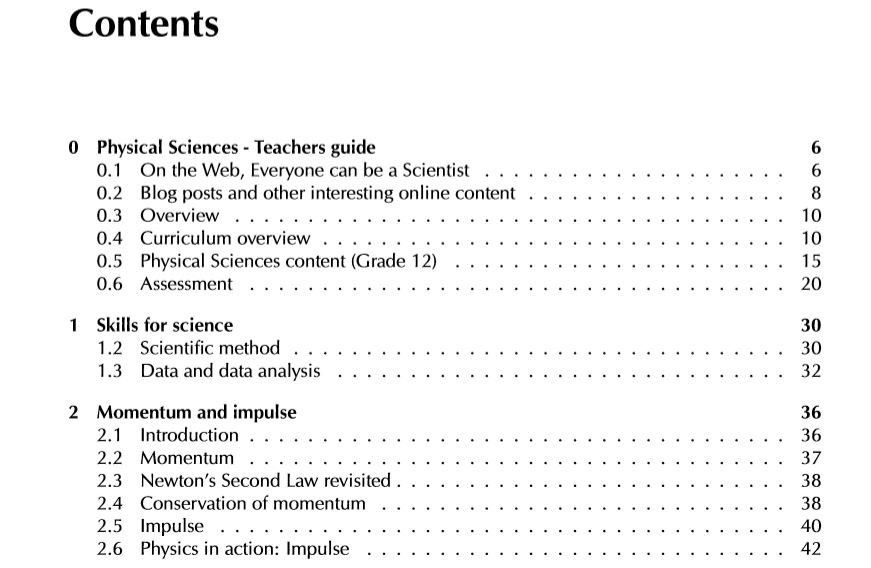JOIN OUR WHATSAPP GROUP. CLICK HERE
Siyavula Physical Science Grade 12 PDF Download
Siyavula Physical Science Grade 12 PDF Download Download the Siyavula Physical Science textbook, grade 12: We cannot help but be astounded by the immense diversity and complexity of life when we glance outside at everything in nature, look around us at everything produced, or look up at everything in space; so many things, that look so different, operate in such distinctive ways. Really, the physical cosmos is incredibly intricate.
But much more amazing than this apparent complexity is the fact that knowledge of objects in the actual universe is possible. We are able to look at, examine, and comprehend them. We are able to alter materials and advance technology thanks to our understanding of the physical cosmos.
Siyavula Physical Science Grade 12

Download Siyavula Physical Science Grade 12 (pdf)
Covered on this content
- Chapter 1: Skills for science
- 1.1 The development of a scientific theory
- 1.2 Scientific method
- 1.3 Data and data analysis
- 1.4 Laboratory safety procedures
- Chapter 2: Momentum and impulse
- 2.1 Introduction
- 2.2 Momentum
- 2.3 Newton’s Second Law revisited
- 2.4 Conservation of momentum
- 2.5 Impulse
- 2.6 Physics in action”:” Impulse
- Practice this chapter
- Chapter 3: Vertical projectile motion in one dimension
- 3.1 Introduction
- 3.2 Vertical projectile motion
- 3.3 Chapter summary
- End of chapter exercises
- Practice this chapter
- Chapter 4: Organic molecules
- 4.1 What are organic molecules?
- 4.2 Organic molecular structures
- 4.3 IUPAC naming and formulae
- 4.4 Physical properties and structure
- 4.5 Applications of organic chemistry
- 4.6 Addition, elimination and substitution reactions
- 4.7 Plastics and polymers
- 4.8 Chapter summary
- End of chapter exercises
- Practice this chapter
- Chapter 5: Work, energy and power
- 5.1 Introduction
- 5.2 Work
- 5.3 Work-energy theorem
- 5.4 Conservation of energy
- Exercises
- 5.5 Power
- 5.6 Chapter summary
- End of chapter exercises
- Practice this chapter
- Chapter 6: Doppler effect
- 6.1 Introduction
- 6.2 The Doppler effect with sound
- 6.3 The Doppler effect with light
- 6.4 Chapter summary
- End of chapter exercises
- Practice this chapter
- Chapter 7: Rate and Extent of Reaction
- 7.1 Introduction
- 7.2 Rates of reaction and factors affecting rate
- 7.3 Measuring rates of reaction
- 7.4 Mechanism of reaction and catalysis
- 7.5 Chapter summary
- End of chapter exercises
- Practice this chapter
- Chapter 8: Chemical equilibrium
- 8.1 What is chemical equilibrium?
- 8.2 The equilibrium constant
- 8.3 Le Chatelier’s principle
- 8.4 Chapter Summary
- End of chapter exercises
- Practice this chapter
- Chapter 9: Acids and bases
- 9.1 Acids and bases
- 9.2 Acid-base reactions
- 9.3 pH
- 9.4 Titrations
- 9.5 Applications of acids and bases
- 9.6 Chapter summary
- Practice this chapter
- Chapter 10: Electric circuits
- 10.1 Introduction
- 10.2 Series and parallel resistor networks (Revision)
- 10.3 Batteries and internal resistance
- 10.4 Evaluating internal resistance in circuits
- 10.5 Extension”:” Wheatstone bridge [Not examinable]
- 10.6 Chapter summary
- End of chapter exercises
- Practice this chapter
- Chapter 11: Electrodynamics
- 11.1 Introduction
- 11.2 Electrical machines – generators and motors
- 11.3 Alternating current
- 11.4 Chapter summary
- End of chapter exercises
- Practice this chapter
- Chapter 12: Optical phenomena and properties of matter
- 12.1 Introduction
- 12.2 The photoelectric effect
- 12.3 Emission and absorption spectra
- 12.4 Chapter summary
- End of chapter exercises
- Practice this chapter
- Chapter 13: Electrochemical reactions
- 13.1 Revision of oxidation and reduction
- 13.2 Writing redox and half-reactions
- 13.3 Galvanic and electrolytic cells
- 13.4 Processes in electrochemical cells
- 13.5 The effects of current and potential on rate and equilibrium
- 13.6 Standard electrode potentials
- 13.7 Applications of electrochemistry
- 13.8 Chapter summary
- Practice this chapter
- Chapter 14: The chemical industry
- 14.1 Introduction
- 14.2 Nutrients
- 14.3 Fertilisers
- 14.4 The fertiliser industry
- 14.5 Alternative sources of fertilisers
- 14.6 Fertilisers and the environment
- 14.7 Chapter summary
- End of chapter exercises
- Practice this chapter
Download Past Exam Papers & Memo per Province
- Department of Basic Education Grade 9 Exams
- Eastern Cape Papers and Memorandum
- Free State Papers and Memorandum
- Gauteng Papers and Memorandum
- KwaZulu-Natal Papers and Memorandum
- Limpopo Papers and Memorandum
- Mpumalanga Papers and Memorandum
- Northern Cape Papers and Memorandum
- North West Papers and Memorandum
- Western Cape Papers and Memorandum
JOIN OUR TELEGRAM CHANNEL. CLICK HERE

Be the first to comment